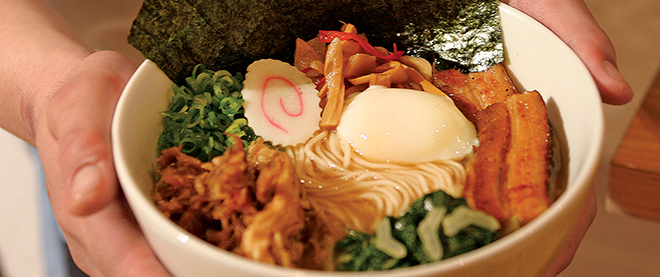Ramen: a balanced universe in a bowl
The Japanese dish’s alchemy of humble ingredients is only beginning its culinary ascent
Andrew Scrivani/The New York Times
Share

In December, the first issue of Lucky Peach, a quarterly food journal produced by Momofuku mogul and chef-of-the-moment David Chang, sold on eBay for $162.50 to $152.50 more than its newsstand price in June 2011. Crazy? Not to anyone up on food trends: the issue is devoted to ramen, the Japanese broth-noodle combo once best known as a mainstay for starving students. But that was before forces—cultural, economic, primal—transformed it into the new cosmic chicken soup for the soul, metaphorically and culinarily speaking.
We’re currently in the grip of ramen mania, as illustrated by thousands of Instagrams of wheat noodles in glistening hot broth topped with sliced pork, mushrooms, egg, corn, seaweed, green onion, pickled bamboo shoots—you name it. The dish’s Vancouver toehold has increased and migrated east, with shops opening up in Toronto and beyond, seemingly with the frequency of Starbucks. Chatter on Chowhound message boards has turned to critiques of tare, the seasoned sauce that defines ramen type: miso, fermented bean paste; shoyu, soy-sauce based; shio, salty seafood and seaweed essence; and tonkotsu, creamy pork-bone broth. Studying ramen-making in Japan has become a chef’s bragging right, the way training at former molecular cuisine mecca El Bulli used to be.
Ivan Orkin, a New York chef turned ramen celebrity in Japan, sees the trend only beginning in North America. The self-described “Japanophile” moved to Tokyo in 2003 amid a ramen renaissance. His two Ivan Ramen shops, which offer a “Mexican” and a “BLT” ramen, were big hits; he also gained fame selling high-end instant ramen. Orkin is about to open his first U.S. outpost in Manhattan’s Lower East Side this spring. He’s publishing a book in the fall.
Orkin credits Chang, the Korean-American famed for putting a high-end spin on Asian street food, for giving ramen culinary cred in North America in the mid 2000s: “He made it okay to go to a restaurant and have a big bowl of noodles.” Chang, who studied ramen-making in Japan, says the allure for him is part nostalgia: “I used to come home after school as a kid and eat instant ramen right out of the wrapper,” he tells Maclean’s. (He named his restaurants in homage to Momofuku Ando, who invented instant ramen in 1958 as a perfect postwar food capable of feeding the world.) Carbs in hot broth is elemental, Chang says. “It’s delicious; it’s universal.”
Ramen’s association with cheap packaged foods has tarnished its reputation, says Brian MacDuckston, an American expat who runs the Tokyo-based blog, Ramen Adventures, and is the go-to guy for Western food writers wanting to tour the ramen epicentre. “Once people try real ramen made from scratch, it’s an eye-opener,” he says. So are cinematic odes to the integrity of ramen-making, such as 1985’s Tampopo (a kind of Japanese Rocky) and the 2008 comedy The Ramen Girl.
Some chefs talk cryptically of the Tao of ramen—the alchemy of humble ingredients required to create a balanced universe in a bowl. Asked what makes a first-rate recipe, Chang offers only that it’s “well-seasoned” and “each element must be right.” The broth has to stick to the noodles, according to Orkin. Ramen is a delicate balance, says MacDuckston: “tare for initial impact, broth for the lasting umami [pleasant savoury taste], noodles and toppings for nourishment.”
Such nuanced simplicity is part of ramen’s appeal. If molecular cuisine—a parade of gelled, dehydrated, foamed wonders—provided culinary foreshadowing of a vaporous, unstable economy, ramen is its opposite: warming, low-tech, low-budget fare that taps into the fear that we all could be starving students again.
Ramen is “über-comfort food,” says Orkin. “It’s fun. You get messy; your blouse gets splashed, you make noise, you know you’re eating lot of calories.” It’s also a great equalizer, says MacDuckston. The business runs on volumes and turning tables; reservations aren’t accepted. As such, it’s “snob-proof,” he says—a nice thought, though the crazy prices being offered for ramen memorabilia suggests that may not be the case for long.